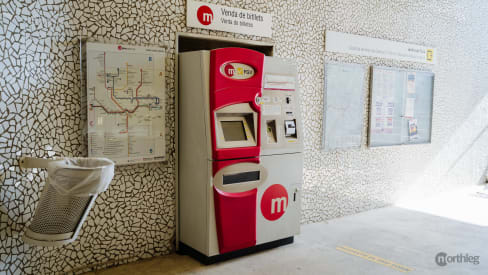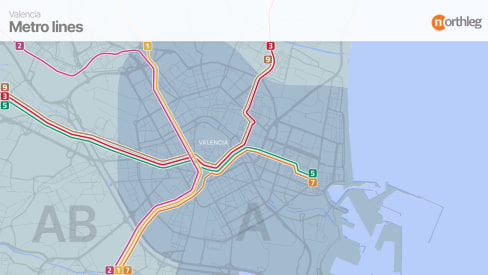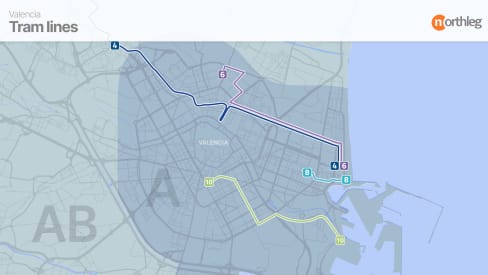Metro and tram
Metro and tram
There are a total of six metro lines and four tram lines in Valencia, covering the city’s urban area and its surroundings pretty well.
Normally, in underground metro stations, you will find turnstile gates at entrance and exit points. You will need to tap your ticket or transport card on the red circle in order to open the swinging barriers and access the platforms. You will also need to tap on your way out with the same ticket.

However, in some above-ground stations (often located in the outskirts of the city), you will find free access to the platforms. This doesn’t mean you don’t have to tap your card. You must tap your card on the column-like access control devices.
The system is the same, you tap your card on the red circle and after the sound your card is registered. If you don’t do this and metro security checks your card, they will fine you.

The metro and tram services are great if you need to reach your destination quickly, avoiding congested traffic. The trains are frequent and reliable: there is a train available once every few minutes, depending on the line. However, if you don’t have a specific plan or just want to take the city in as you are going, the metro might not be your best option.
Most stations are fully accessible for people with reduced mobility, with a small gap between train and platform. Companions of wheelchair users should be eligible for free travel. For more info about accessibility in Valencia’s metro stations, have a look at the MetroValencia website .
If you want more information about this service, have a look at our article about the metro and tram in Valencia.
Tickets
Public transport discounts - 1st September to 31st December 2022
The Valencian government has introduced a 30% discount on public transport passes.
The price of a SUMA 10 pass (valid for metro, tram, buses, and railways) down to €5.60 (one zone), €8.40 (two zones), and €14.00 (three zones).
Single tickets remain the same as always.
Free Transport Under 30 - 9th October - 31st December 2022
Free public transport (metro, trams, and buses) is available in Valencia for people under 30.
To benefit from this initiative, users have to request their free transport card online. The only prerequisite is a Spanish DNI or NIE as proof of age.
Public transportation passes or tickets can be purchased in many different places. If you want more in-depth information, you can check out this article about available tickets and where to get them.
However, if you are using the metro, the simplest way to get a ticket is directly at a metro station. You can do so either at an automated machine or with the help of a clerk at a stand.
All automated machines will have a selection of languages to choose from, including English. You will have many options: single tickets, 10-journey tickets, transportation passes for a number of days (and passengers). You will also be able to choose the areas that you want to cover.

Remember that any multiple-journey SUMA pass will be also valid for other transportation services in the selected areas.
If you have a Spanish phone number, you will also be able to recharge your SUMA pass on the app RecargaSUMA (for Android) , which replaced the app previously known as RecargaMobilis. Meanwhile, single tickets remain valid only for the metro.
Another great option is the Valencia Tourist Card (VTC). This is a discount card valid for one, two, or three days. The card gives you free public transportation (bus, metro, tram) in all zones, free entry to museums and monuments, and up to 50% discount on tourist services, shops, and restaurants.
Remember to always tap your card on the red circle on access control devices, regardless of the type of transport card or metro station.
Metro lines
As mentioned, there are a total of ten lines. These lines cover 146 stations, of which 38 are underground. Nine of these stations are in the central area of the city.
Let’s have a look at the six metro lines:
| Line |
|---|
| Colour |
| Zones covered |
| Beginning and end of line |
| Details |
| Line | 1 | 2 | 3 | 5 | 7 | 9 |
|---|---|---|---|---|---|---|
| Colour | Yellow | Pink | Red | Green | Orange | Brown |
| Zones covered | A-B | A-B | A-B-C | A-B-C | A-B | A-B |
| Beginning and end of line | Bétera - Villanueva de Castellón | Lliria - Torrent Avinguda | Rafelbunyol - Aeroport | Aeroport - Marítim | Torrent Avinguda - Marítim Serrería | Alboraia Peris Aragó - Riba roja de Túria |
| Details | It is the longest metro line and crosses the Municipality of Valencia north to south. In the centre, it takes a route that stops near a large mall, by the Turia park, then proceeds straight down to Plaza de España, not far from the train station. Afterward, it continues towards the outskirts of the city. | It connects two towns, north-west and south-west respectively, passing through Valencia city. In the centre, it takes the same route as line 1. | It connects the airport with a town north of Valencia, passing through the city. It stops by some of the busiest spots in Valencia, like Ángel Guimerá, Xátiva (by the main train station), and Colón. After stopping at Alameda, in the Turia park, it proceeds towards the outskirts. | It connects the airport with the neighbourhoods by the sea. In the city centre, it takes the same route as line 3, but after Alameda, it continues towards the beach. Its last stop is located by the picturesque Cabanyal, a former fishermen’s neighbourhood. | This line connects a town southeast of Valencia with the city and its seaside neighbourhoods. In the urban area, the line comes up from behind the train station, stopping in Xátiva, Colón, and Alameda. | This line takes a route that connects two towns, one northeast and the other north of Valencia, passing of course by the city. Its path in the city centre is the same as lines 3 and 7. |

Tram lines
The remaining four are the tramlines:
| Line |
|---|
| Colour |
| Zones covered |
| Beginning and end of line |
| Details |
| Line | 4 | 6 | 8 | 10 |
|---|---|---|---|---|
| Colour | Blue | Lilac | Light Blue | Light Green |
| Zones covered | A-B | A | A | A |
| Beginning and end of line | Mas del Rosari - Dr. LluchORLl Llarga Terramelar - Empalme | Tossal del Rei - Marítim | Marítim - Neptú (previosuly Marina Reial Joan Carles I) | Alacant - Natzaret |
| Details | Its first route connects a town northwest of Valencia with the seaside neighbourhoods. Its final stops are less than 300 metres (around 330 yards) from the beach.Its second route covers a short distance between areas in north Valencia. | It connects a neighbourhood in the north of Valencia’s urban areas with the seaside neighbourhoods. On its route, it passes by the university area. | The shortest tram line, with only four stops. It connects the end of metro lines 5 and 7, with the beach. Neptú is about 300 metres (around 330 yards) from the beach. | This line covers areas southeast of the centre. The route goes from the train station area, through Ruzafa, and then towards Ciudad de Artes and the harbour. |

Getting around by metro is the best option if…
- You want to avoid city traffic.
- You want to cover big distances in a short time.
- You want reliable, frequent services.




















